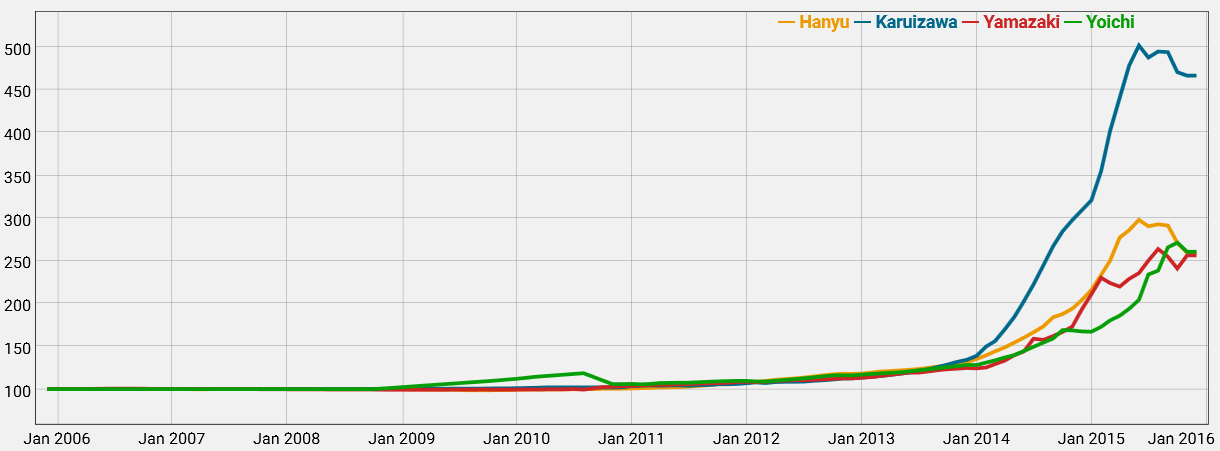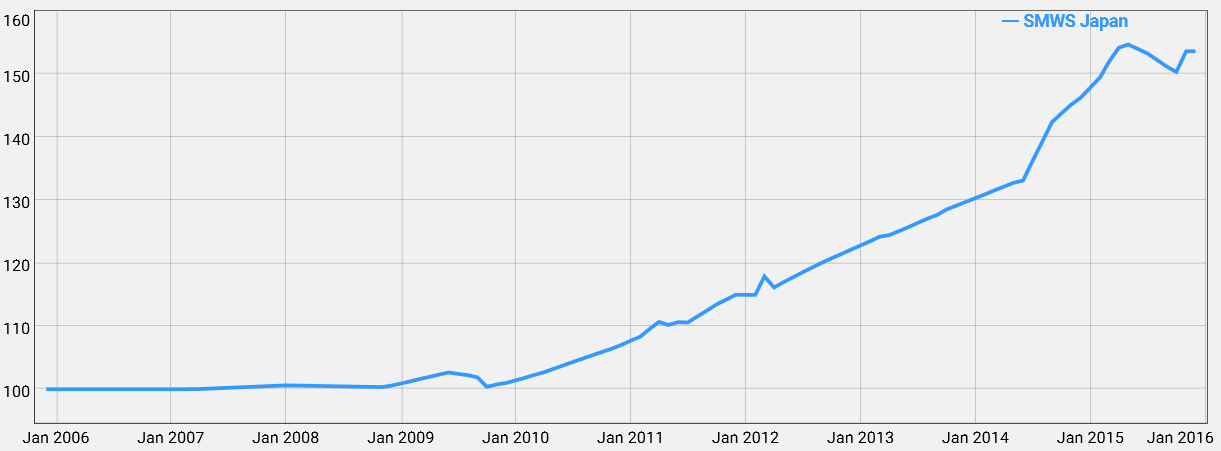Few trends have dominated the secondary whisky market as the boom of japanese whiskies did. While the gold rush seems to be over (or is it?), we wonder in which direction the nippon trend will evolve. That said, it is about time to add japanese whiskies to our database!
Measured by the number of bottles in our whisky database, Japan is the smallest whisky producing region relevant on the secondary market. By November 2015, you will find the price evolutions of 402 different japan distilled whiskies in our database. And good lord of the drinks, some of these price histories compare to no other!
Japan on Top
But we will do this step by step. When adding a new region, the first thing that comes in mind is computing the corresponding region index. We sure did, and the result made us reviewing our source code once more. But all seems right, so we move on.
The index includes 1507 prices of the 100 most traded japanese whiskies. By November 2015, it closes at about 525 points. That means, the value of these bottles quintupled over the last decade. Actually, it did that in the last three years! But there’s more. Over the course of the first six months of the year 2015 the index climbed from 355 to 570 points. This equals a 60% increase in value over a half-year period. So is everything rosy in the garden of the rising sun? Not quiet. In the five months following this June 2015 peak these bottles lost almost 8% in value.
The Japanese Distilleries
All in all, our database covers 11 different japanese whisky distilleries. Out of these 11 distilleries, only 4 meet our criteria of having 10 bottlings with each 5 price observations to calculate an index. These are Hanyu, Karuizawa, Yamazaki and Yoishi.
The direct comparison of these indices reveals some interesting patterns. All indices lost ground in the last couple of months. So it seems like it is indeed a small setback of all japanese whiskies and not only from those of one particular distillery. The most obvious observation is that the index of the Karuizawa distillery tops the others by more than 200 points. For this Karuizawa index, we considered 95 different bottlings and more than 1200 price observation. This makes it the most traded japanese distillery and also dominating our Japan index we saw earlier. Somehow curious is that the indices of Hanyu, Yamazaki and Yoishi all close at around 260 points by November 2015. The above graphs also show us, that the japanese whisky boom really kicked off at the beginning of 2014.
SMWS’s Japan Adventure
When looking at the bottlers of japanese whiskies, we see that more than 80% are bottled by the respective distillery itself and therefore are listed as original bottlings. The biggest independent bottler of japanese whiskies in our database is the Scotch Malt Whisky Society (SMWS). In total we find 35 different bottlings from Hakushu, Karuizawa, Miyagikyo, Yamazaki and Yoishi which are bottled by the SMWS. If we take those 15 out of 35 SMWS Japan bottlings for which we observed more than four different prices, we can form a SMWS Japan index.
In contrast to the other japanese indices we have seen so far, the SMWS index began its growth as early as in the beginning of the year 2010. What followed was a steady increase until the mid of the year 2015. Like for the other indices, we observed an additional “increase in increase” around January 2015. From May to October 2015 though, the SMWS bottlings also lost value. So it seems like that japanese whiskies bottled by the SMWS caught the attention of whisky connoisseurs and collectors a few years before the big japan whisky boom set in.
Japanese Cherries
It is time to turn our attention on some truly outstanding price evolutions. There are, of course, many japanese whiskies which experienced a dramatic increase in price. So for the following listing we only cherry picked some observations and invite you to browse the others in our whisky database.
The Bargain:
Back in the beginning of the year 2013, you could have bought a bottle of the Karuizawa 31yo (Vintage 1981) Sakura for around 800 Euros. Sure, you may argue that this is a lot of money for a single bottle of whisky. But if you compare that to the latest price observations of more than 15.000 Euros (!) you probably agree that it was quite a bargain back then.
The Mirror:
The Karuizawa 37yo (Vintage 1971) from cask 6878 perfectly mirrors the japanese whisky index. First time the prices for this whisky climbed above 1000 Euros was in March 2015. By June 2015, the price reached almost 3800 Euros before it dropped back to 3500 Euros in November 2015.
The Climber:
The Hanyu 18yo (Vintage 1990) Ten of Clubs is the japanese whisky with the highest relative increase in value in our database. First price observations date back to the year 2011 where it was sold for around 100 Euros. A price observation of more than 2800 Euros in this year caused a relative price change of more than 2700%.
The Late One:
A little more than one year ago, you could have got the Yamazaki Single Malt Whisky Sherry Cask for around 130 Euros. Just 12 months later, almost the tenfold (1250 Euros) was paid for one of these bottles. So not only the early birds flew high.
The japanese whiskies are now part of the whiskystats whisky database. That means, they will be covered by our monthly price update and we will be able to monitor their future price movements. Our first glimpse at this data revealed some truly impressive development of the market for japanese whiskies. From what we saw we can conclude that the big boom set in at the beginning of 2014 and exploded in the first half of 2015. The already mothballed Karuizawa distillery is without a question the most wanted japanese distillery. The prices of the corresponding most traded Karuizawa bottlings quintupled over a two-year period. The japanese whisky’s price rally experienced its peak (for the time being) in Summer 2015. Since then, prices slightly decline.
This marks the end of our introduction of the japanese whiskies to the world of whiskystats. We will, of course, cover the one or the other more specific selection of these whiskies in one of our upcoming articles. So long, Arigatou and Sayounara!
